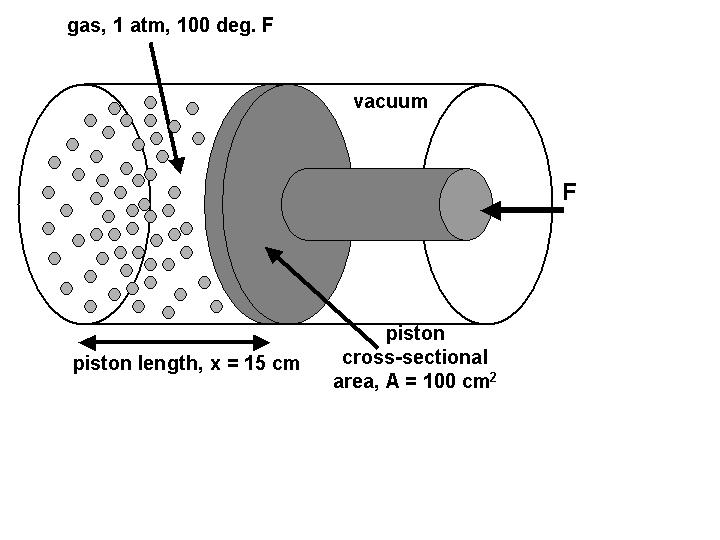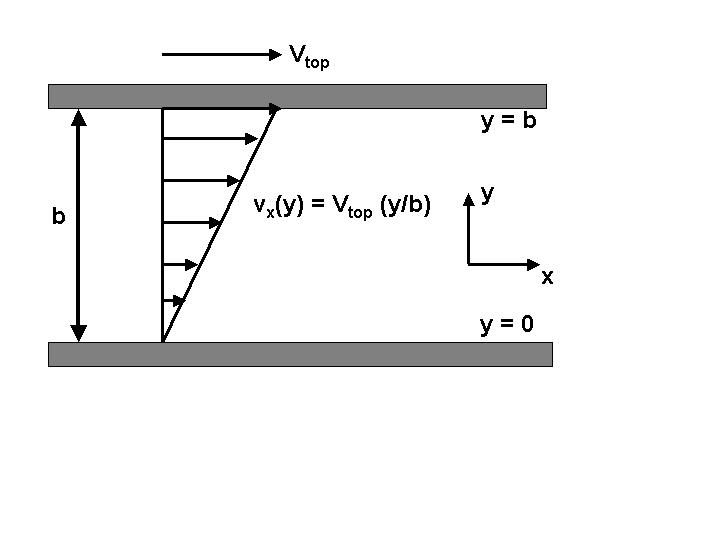
Spring 2002. 10.301.
Introduction to Fluid Mechanics
Assignment 1.
Due 2/14/2002
There are four
questions to this assignment. For grading purposes, please
begin each question on a separate page.
1.
We have a piston, of cross-sectional area A = 100 cm2,
in which a dilute nitrogen gas is constrained by a moving wall.
Initially, the distance between the stationary and moving walls
of the piston, x, is 15 cm, and the piston chamber is
filled with gas at a pressure of 1 atmosphere and a temperature
of 100 degrees F. Outside the piston is a vacuum.

We
now compress the gas by decreasing the piston length x
from 15 cm to 10 cm. If we move the piston very slowly, there
will be enough time to add or remove heat from the surroundings
after each small movement of the piston so that we may assume
that the temperature remains constant at 100 degrees F. You may
assume that the ideal gas law is a reasonable description of the
PV behavior of the gas. Answer the following questions:
1.a.
What is the inward force required to hold the piston at its
original position at x = 15 cm?
1.b.
After the compression, what is the density of the gas, reported
in SI units of Kg/m3? The gas in the piston is
nitrogen, N2.
1.c.
What is the inward force on the piston shaft required to maintain
the piston length at 10 cm? Report your answer in SI units (force
unit = 1 Newton).
1.d.
What is the net work that must be performed to compress the
piston length from 15 cm to 10 cm? Report your answer in SI units
(work,energy unit = 1 Joule = 1 N*m).
1.e.
If we now assume that the outside of the piston is no longer a
vacuum, but is rather a gas with a constant pressure of 1
atmosphere and a temperature of 100 degrees F, what is the new
value of the work required to change the piston length from 15 cm
to 10 cm?
2.
Viscosity has the SI units of Pa*s, where 1 Pa (Pascal) = N/m2,
a measure of pressure. Unfortunately, one often encounters values
of viscosity reported in different units, in particular the CGS
(cm-g-s) system in which the unit of viscosity is defined as 1
Poise = 1 dyne-s/cm2, a dyne being the CGS unit of
force. For example, the viscosity of water is usually reported
to be about 1 centipoise = 1 cP = 0.01 P. Perform the unit
conversions necessary to calculate the viscosity of water in SI
units.
3.
In class, we said that if we had a fluid confined between two
plates separated by a distance b, with the bottom plate
stationary and the top plate moving at a constant velocity Vtop
in the x direction, then we could expect the steady state
velocity field to be linear in y.

3.a.
For water, using the viscosity calculated in question 2, what is
the force per unit area, reported in units of pressure 1 Pa = N/m2,
that must act on the top plate to move it at a velocity of 1 cm/s
if the plates are separated by a distance of 10 cm?
As
long as we move the top plate very slowly, the flow will be
steady and uniform (laminar), but if we move the top plate too
fast, we will get an irregular, unsteady, turbulent flow. As
discussed in class, the parameter that controls whether we will
observe turbulence is the Reynolds number, defined for our
experiment as
Re = r Vtop b / m
When
the Reynolds number is more than one or two orders of magnitude
greater than one, the inertia of the moving fluid is too large
for the viscous forces to “smooth” any irregularities
in the velocity field, and the flow becomes turbulent. In our
calculation above, we have assumed that this is not the case.
3.b.
Make sure that we are justified in making this approximation by
calculating the Reynolds’ number for this flow example.
3.c.
How fast would we have to move the top plate, in m/s, in order to
have a Reynolds’ number of 100, where we would have to begin
considering the possibility of turbulent flow?
4.I have a balloon of
volume 200 cm3, filled with water with a density of 1
g/cm3. I drop the balloon out my fifth floor window in
building 66 that is, say, 60 feet off of the ground, right as a
bunch of noisy students from the East Campus dorm are walking
underneath.
4.a. What is the
momentum of the balloon right before it hits the ground?
4.b. Based on your
reasoning, if I have a “chunk” of fluid of density r,
occupying a volume V, and moving with a velocity vector v,
what is the linear momentum of this fluid “chunk”?
4.c. What is the momentum per unit volume carried by the fluid as it moves? Since mass per unit volume is the mass density, we could call this value the momentum density of the fluid.